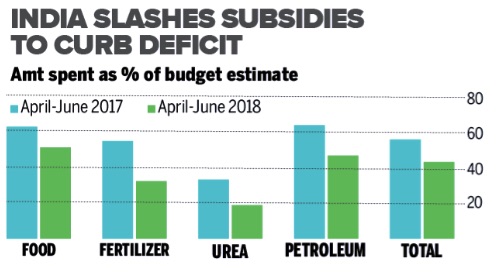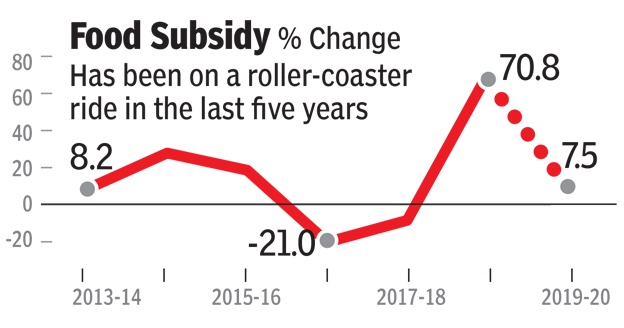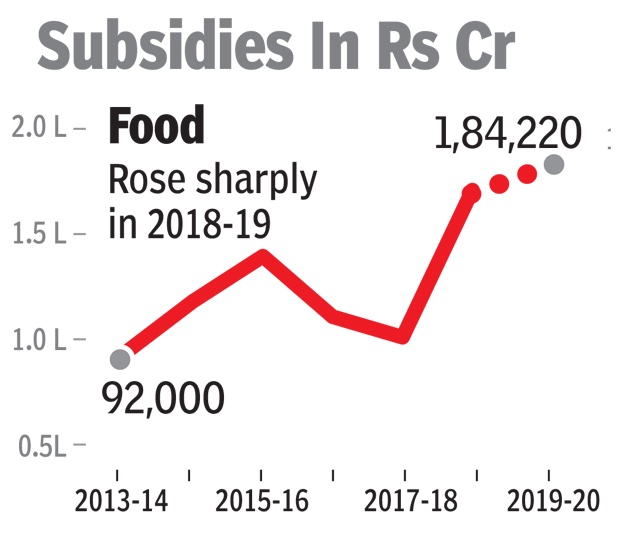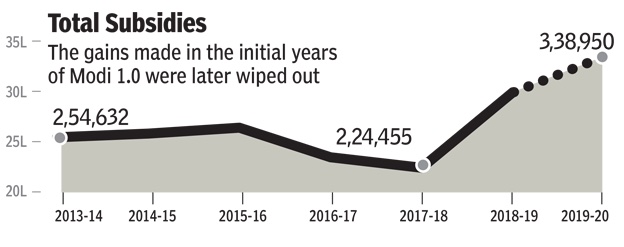Subsidies (government subsidies): India

This is a collection of articles archived for the excellence of their content. |
Contents |
Impact on deficit
2017> ’18: Subsidies reduced but not deficit
August 7, 2018: The Times of India

From: August 7, 2018: The Times of India
India is spending less on subsidies to narrow its budget gap. In three months of FY2018, it spent Rs 11.7 lakh crore ($17 billion) on major subsidies, less than Rs 13.5 lakh crore ($19.6 billion) doled out a year ago. India recorded a fiscal deficit of $62.57 billion for April-June, or 68.7 per cent of the budgeted target for the current fiscal year. It was 80.8 per cent a year ago. For 2018-19, the government has set a fiscal deficit target of 3.3 per cent of GDP against a revised estimate of 3.5 per cent in 2017-18. This is surely a sign of fiscal consolidation, but at a slower pace than that recommended under the Fiscal Responsibility and Budget Management (FRBM) framework.
National subsidies
2013-19
July 6, 2019: The Times of India

From: July 6, 2019: The Times of India

From: July 6, 2019: The Times of India

From: July 6, 2019: The Times of India

From: July 6, 2019: The Times of India

From: July 6, 2019: The Times of India

From: July 6, 2019: The Times of India

From: July 6, 2019: The Times of India

From: July 6, 2019: The Times of India
One of the positive legacies of UPA govt was subsidy control. Under NDA, it first came down, then went up. Here's a look at the change across food, petroleum, fertiliser and other subsidies over the years.
State-wise, statistics
Assam
2016

See graphic:
Subsidies, Assam
Kerala
2016

See graphic:
Subsidies: Kerala
Tamil Nadu
2016
The Times of India, Mar 10 2016

Sivakumar B
Amma spoils all with dosa, rice and curd
AIADMK, which traditionally restricted welfare to basic necessities, changed tack in 2011, promising everything from goats to grinders even though the 2G scam had already built up anti-incumbency against DMK.
After winning the election, the Amma canteens, pharmacies, cement and bottled water followed -the cost of the welfare schemes for the past 5 years has crossed the Rs 43000-crore mark.
The state-run canteens, especially the ones that cater to urban poor and migrant workers, have been widely appreciated.
The concept is now being adopted by other states also.
The AIADMK government has spent several thousand crores on various welfare schemes with food subsidy alone costing Rs 25,000 crore. But there are outliers too. Anbumani Ramadoss' PMK, for instance, has promised to do away with the freebie model of governance.
DMK has criticised Jayalalithaa's Amma-branded schemes but remains silent on its own freebies such as television sets.
Analysts say schemes such as subsidised canteens and pharmacies will continue. Their names might change if there's a change in the ruling dispensation just as AIADMK changed the name of the free medical insurance scheme when it assumed office five years ago.
But Ramadoss is certain freebies will not have an impact on the voters' decisions. “In 2006 alone, there was an impact the DMK's `1 kg rice for Re 1' scheme made a difference But in the last election, even after offering so many freebies, DMK came third,“ he said.“PMK will offer free services such as quality health care, education, transport instead.“
West Bengal
2016

See graphic:
Subsidies, West Bengal